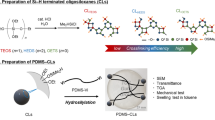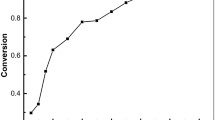Abstract
The effect of oil length of alkyds and substitution of siloxane backbone has been studied for alkyd–siloxane hybrids. A series of nine alkyd–siloxane hybrids were synthesized by either varying the oil length of the alkyd or the siloxane backbone substitution. Three linseed oil-based alkyds with either a long, medium, or short oil length were grafted with three hydride-terminated siloxanes substituted with methyl, cyclopentyl, or cyclohexyl groups. A hydrocoupling reaction was used to couple the telechelic siloxane with the hydroxyl functionality of the alkyds using Wilkinson’s catalyst. The reaction was monitored by the disappearance of siloxane hydride signal using Fourier transform infrared. Characterization of siloxane–alkyd hybrids was performed using 1H-NMR, 13C-NMR, and gel permeation chromatography. The hybrids were formulated with a Co, Zr, and Ca drier package and auto-oxidatively cured without using any solvent. The tensile, viscoelastic, and coating properties were evaluated for the cured films. The crosslink density, flexibility, and reverse impact resistance were found to increase as a function of oil length. Tensile modulus, elongation-to-break, glass transition temperature, drying time, and fracture toughness decreased with increase in oil length. For the alkyd–siloxane hybrids, the mechanical and rheological properties were dependant on the size of the substituents. The larger-sized cyclopentyl and cyclohexyl groups resulted in better mechanical and rheological properties than the methyl-containing siloxanes.








Similar content being viewed by others
References
Gooch, JW, Bufkin, GB, Wildman, GC, “Coating Binders from Vegetable Oil Material.” US Patent 4419139, 1983, 6 pp
Soucek, MD, “Inorganic/Organic Hybrid Coatings.” In: Kickelbick, G (ed.) Hybrid Materials-Synthesis, Characterization and Applications, Wiley-VCH, Weinheim (2007)
Bentley, J, “Composition, Manufacture and Use of Paint.” In: Caddy, B. (ed.) Forensic Examination of Glass and Paint: Analysis and Interpretation, p. 138. CRC Press, NY (2001)
Piekarski, G, Kippe, D, Kurz, D, Hundmeyer, A, Maier, S, “Low-Pressure Polyethylenes.” US Patent 3991259, 1975, 28 pp
Hofland, A (1994) “Water-Borne Coatings for Decorative and Protective Coatings: A Comparative Survey.’’ Surf. Coat. Int. 77 (7) 270–272
Kraft, WM (1962) “Alkyds-Past, Present, and Future?“ J. Am. Oil Chem. Soc., 39 (11) 501–502
Fenzell, WA (1982) “Low VOC Silicone Alkyd Copolymers for Maintenance Paint Applications.” J. Water Borne Coat., 5 (3) 3–6
Brady, SA, Johnson, JC, Lyons, JD, “Reactive Silicone Resin Intermediates. Effects of Silicone Content on Typical Coatings.”Paints Varnish Prod., 48 (1) 25–31 (1958)
Emblem, HG, Marsden, C, Stockwell, GE, “Silicon-Modified Plastics.” Plastics (London), 12 (137) 525– 527 (1948)
Smith, AL, Brown, LH, Tyler, LJ, Hunter, MJ (1957) “Thermal stability of resins.” J. Ind. Eng. Chem. 49 1903–1906
McLean, WM, “Coating Compositions from Silicone-Alkyd Resins and Epoxy Resins.” US Patent 2687398, 1954
Rose, K, “Silicones-Properties and Uses.” Mater. Methods, 41 (2) 109–124 (1955)
Stebleton, LF, Hedlund, RC, “Silicones in the Paint Industry.” Paint. Ind. Mag., 69(10) 14–16 (1954)
Hedlund, RC (1959) “Silicone in Industrial Finishes.” Prod. Finish. (Cincinnati), 23 (9) 146–58
Karim, AFA, Golding, B, Morgan, RA (1960) “Silicone-Alkyd Copolymers and their Application to High-Temperature Surface Coatings.” J. Chem. Eng. Data., 5 (1) 117–125
Dullius, J, Ruecker, C, Oliveira, V, Ligabue, R, Einloft, S (2006) “Chemical Recycling of Post-Consumer PET: Alkyd Resins Synthesis.” Prog. Org. Coat., 57 (2) 123–127
Kogel, JE, Industrial Minerals & Rocks: Commodities, Markets, and Uses, p. 1308. SME, Littleton, CO (2006)
Wicks, Jr, ZW, Jones, FN, Pappas, SP, “Organic Coating: Science & Technology, Volume II: Applications, Properties and Performance” Wiley, NY (1994)
Bunnell, RH, Hatcher, DB, “Siloxane-Modified Alkyd Resins.” US Patent 2624720, 1953
Hunter, MJ, Rauner, LA, “Condensation of an Organosilane with a Polyhydric Alcohol and Thereafter with a Polycarboxylic Acid.” US Patent 2584351, 1952
Alagar, M, Kumar, AA, Mahesh, KPO, Dinakaran, K (2000) “Studies on Thermal and Morphological Characteristics of E-Glass/Kevlar 49 Reinforced Siliconized Epoxy Composites.” Eur. Polym. J., 36 (11) 2449–2454
Beetsma, J (1998) “Alkyd emulsion paints: properties, challenges and solutions.” Pigm. Resin Technol., 27(1) 12–19
Bukingham, AM, Estes, TN, Gee, MB, Selley, DB, Smith, JM, “Water Repellent Compositions and Using the Same on Wood, Sandstone or Mortar.” US Patent 5695551, 1997, 10 pp
Nagy, J, Hencsei, P, Ambrus, L, Bihatsi, L, Fabulya, EP, “Preparation, Investigation and Application of Modified Silicone Resin Based Varnish Paints.” FATIPEC Congress, 14, pp. 257–261 (1978)
Heilen, W, Silicone Resins and Their Combinations, p. 28. Vincentz Network GmbH & Co, Hannover (2005)
Zhang, R, Mark, JE, Pinhas, AR (2000) “Dehydrocoupling Polymerization of Bis-Silanes and Disilanols to Poly(silphenylenesiloxane) as Catalyzed by Rhodium Complexes.” Macromolecules, 33 (10) 3508–3510
Chakraborty, R, Soucek, MD (2008) ”Synthesis of Amine and Epoxide Telechelic Siloxanes.” Macromol. Chem. Phys., 209(6) 604–614
Patton, TC, “Alkyd Resin Technology”, Wiley, NY (1962)
Graessley, WW (ed.), Advances in Polymer Science: The Entanglement Concept in Polymer Rheology, Vol. 16, p. 179. Springer, NY (1974)
Ballard, RL, Sailer, RA, Larson, B, Soucek, MD (2001) “Fracture Toughness of Inorganic–Organic Hybrid Coatings.” J. Coat. Technol., 73 (913) 107–114
Sailer, RA, Soucek, MD (1998) “Oxidizing Alkyd Ceramers.“ Prog. Org. Coat., 33 (1) 36– 43
Sailer, RA, Wegner, JR, Hurtt, J, Janson, JE, Soucek, MD (1998) “Linseed and Sunflower Oil Alkyd Ceramers.” Prog. Org. Coat., 33 (2) 117–125
Clark, TJ, Lee, K, Manners, I (2006) “Transition-Metal-Catalyzed Dehydrocoupling: A Convenient Route To Bonds Between Main-Group Elements.” Chem. Eur. J., 12 (34) 8634–8648
Kim, C, Kwark, K (2002) “Dehydrocoupling and Diels-Alder Reactions on Siloxane Polymers. “J. Polym. Sci. A: Polym. Chem., 40 (22) 4013–4019
Hofer, R, Daute, P, Grutzmacher, R, Westfechtel, A (1997) “Oleochemical Polyols—A New Raw Material Source for Polyurethane Coatings and Floorings.” J. Coat. Technol., 69 (869) 65–72
Dworak, DP, Soucek, MD (2007) “Synthesis, Characterization, and Evaluation of Amine-Terminated Cycloaliphatic-Substituted Polysiloxanes.” Macromol. Chem. Phys., 208(23) 2502–2509
Gauthier, LA, LeGrow, GE, “Nonprecondensed Silicone-Alkyd Resins.” US Patent 4377676, 1983, 32 pp
Ronald, M, “Alkyd Modified Siloxane Coating Compositions.” CA Patent 504830, 1954
Jones, RG, Chojnowski, J, Ando, W, “Silicon-Containing Polymers: The Science and Technology of Their Synthesis and Applications”, Springer, NY (2000)
Tugtepe, M, Orbay, M, “Investigation of the Heat Resistance and Thermal Oxidative Degradation of Alkyd Resins Modified by Organosilicon Compounds or an Intermediate Polysiloxane by DTA and TG.” Chim. Acta Turcica., 6 (2) 109–141 (1978)
Easton T, Poultney, S (2007) “Waterborne Silicone-Organic Hybrid Coatings for Exterior Applications.” J. Coat. Technol. Res., 4 (2) 187–190
Dworak, DP, Soucek, MD, “Synthesis of Cycloaliphatic Substituted Silane Monomers and Polysiloxanes for Photocuring.” Macromolecules, 37 (28) 9402–9417 (2004)
Flick, EW, “Prepaint Specialties and Surface Tolerant Coatings.”, William Andrew Inc., NY (1991)
Parr, LM, “Rheological and Performance Characteristics of Water Reducible Silicone Alkyds.” Org. Coat. Plast. Chem., 43 148–153 (1980)
Noll, W, “Silicate Bond from the Standpoint of the Electron Theory.” Angew. Chem., 75 123–130 (1963)
Author information
Authors and Affiliations
Corresponding author
Rights and permissions
About this article
Cite this article
Chakraborty, R., Thatte, M. & Soucek, M.D. A new approach to graft siloxanes to alkyds. J Coat Technol Res 6, 471–481 (2009). https://doi.org/10.1007/s11998-008-9155-z
Published:
Issue Date:
DOI: https://doi.org/10.1007/s11998-008-9155-z




